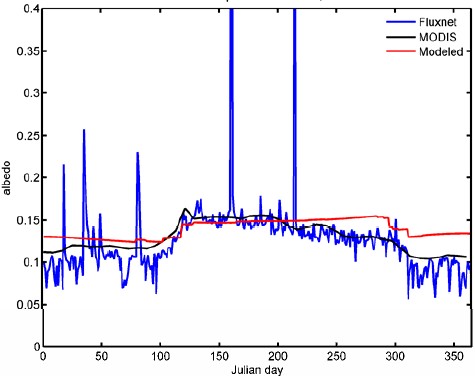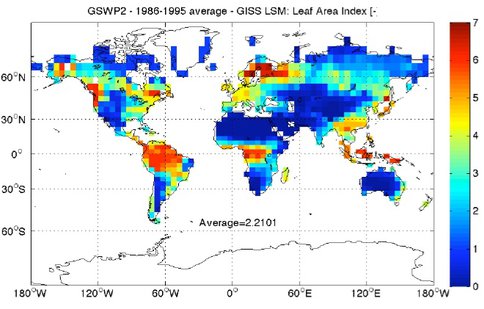2009 Annual Science Report
 VPL at University of Washington
Reporting | JUL 2008 – AUG 2009
VPL at University of Washington
Reporting | JUL 2008 – AUG 2009
The VPL Life Modules
Project Summary
The Life Modules of the VPL are concerned with the modeling of biosphere processes for coupling with the VPL’s atmospheric and planetary models. These coupled models enable simulation of the impact of biogenic gases on atmospheric composition, of biota on the surface energy balance, and of the detectability of these in planetary spectra. The Life Modules team has engaged in previous work coupling 1D models in the VPL’s suite of planetary models, and current work now focuses on biosphere models coupled to 3D general circulation models (GCMs). Current project areas are: 1) development of a model of land-based ecosystem dynamics suitable for coupling with GCMs and generalizable for alternative planetary parameters, and 2) coupling of an ocean biogeochemistry model to GCMs.
Project Progress
For the period July 1, 2008 – October 30, 2009, the Life Modules section of the VPL accomplished the following:
Ent Dynamic Global Terrestrial Ecosystem Model (Ent DGTEM) (Kiang, collaborators at NASA GISS, NASA GSFC, CUNY Hunter College, Harvard). Last year, we coupled in biophysical half-hourly time scale processes of Ent to the GISS and GSFC GCMs. This year, global off-line simulations of Earth seasonal vegetation dynamics is under way, forced with observed meteorology, showing reasonable predictions of leaf area. Balancing of carbon cycling within the Goddard Institute for Space Studies (GISS) GCM has commenced, in tandem with coupling the ocean biogeochemistry model to the GISS GCM (see below). To evaluate Ent DGTEM global scale performance, a new land vegetation dataset of the Earth, including 0.5 × 0.5 degree resolution plant functional type cover, monthly leaf area index, and albedo for 2001-2005, is being derived from MODIS data, crop inventories, and 20th c. climate statistics (Wenge et al.,)
NASA Ocean Biogeochemical Model (NOBM) (Gregg, collaborators at NASA GISS, NASA GSFC). The NOBM is a model previously developed at NASA GSFC that is now being integrated within two modeling systems: the GISS Model E and GMAO GEOS-5 Earth system models. NOBM has been successfully integrated into GISS Model E and is now undergoing validation. Efforts to integrate into GEOS-5 are going slower, due to protocols being followed for the Earth System Modeling Framework.
Life most likely formed first underwater on the Early Earth, since water serves as a solvent as well as providing protection again UV radiation. The ocean biogeochemistry module will afford simulation of such phenomena as sulfur cycling and iron-utilizing anoxygenic photosynthesis on the Early Earth, the stratification of dominant photosynthetic pigments by light quality, and potential variations in the 50% of net primary productivity of life on the modern Earth. Using an earlier OGCM, NOBM was applied to questions relating to early life on Earth in an effort to understand possible scenarios on other planets. A global experiment was conducted using cyanobacteria as the only photosynthetic group in the oceans (i.e., modern diatoms, chlorophytes, and coccolithophores were removed from the standard NOBM configuration). They were consumed by primitive heterotrophic bacteria.
A second experiment involved the removal of consumption of the cyanobacteria by excluding heterotrophic bacteria. This was intended to simulate a scenario in which primitive autotrophs are present but heterotrophs are not. The experiment resulted in model instability. This was due to lack of ammonia regeneration through the process of consumption. The source of the error causing the instability is not known at this time and is under investigation.

Temporal variation of shortwave albedo over one year at a broadleaf deciduous forest in Indiana, with simulations by the Ent DGTEM canopy radiative transfer module compared to site-level and satellite measurements. The Ent DGTEM difference is due to lack of data on seasonality of leaf albedo. The simulated albedo increases over the summer with constant leaf spectra due to seasonal change in the solar zenith angle.
Mean annual leaf area index simulated by the Ent Dynamic Global Terrestrial Ecosystem Model forced by observed meteorology for 1986-1995. Predictions from Ent are being evaluated against MODIS datasets of land cover, leaf area, and abledo.
Publications
-
Ni-Meister, W., Yang, W., & Kiang, N. Y. (2010). A clumped-foliage canopy radiative transfer model for a global dynamic terrestrial ecosystem model. I: Theory. Agricultural and Forest Meteorology, 150(7-8), 881–894. doi:10.1016/j.agrformet.2010.02.009
- Kiang, N.Y., Kharecha, P., DelGrosso, S., Aleinov, I., Puma, M. & Y., K. (Dec. 15-19, 2008). Seasonal and Long-Term Behavior of Soil and Autotrophic Respiration in the Ent Dynamic Global Terrestrial Ecosystem Model. American Geophysical Union Fall Meeting. Moscone Convention Center, San Francisco, CA.
- Yang, W., Kiang, N.Y. & Ni-Meister, W. (2009). Prognostic spectral albedoes in an analytical, clumped-foliage canopy radiative tranfer scheme for a dynamic vegetation model: sensitivity to end member spectra and vegetation structure. 2nd HyspIRI Science Workshop. Sheraton Hotel, Pasadena, CA.
-
PROJECT INVESTIGATORS:
-
PROJECT MEMBERS:
Watson Gregg
Co-Investigator
-
RELATED OBJECTIVES:
Objective 1.2
Indirect and direct astronomical observations of extrasolar habitable planets.
Objective 6.1
Effects of environmental changes on microbial ecosystems
Objective 6.2
Adaptation and evolution of life beyond Earth
Objective 7.2
Biosignatures to be sought in nearby planetary systems

